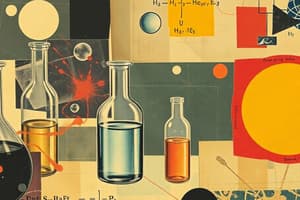Podcast
Questions and Answers
Which indicator is NOT one of the observable signs of a chemical reaction?
Which indicator is NOT one of the observable signs of a chemical reaction?
- Change in color
- Change in state of matter (correct)
- Change in temperature
- Formation of a precipitate
Which form of electromagnetic radiation has the highest frequency?
Which form of electromagnetic radiation has the highest frequency?
- Ultraviolet
- Gamma rays (correct)
- Microwaves
- Radio waves
What is the primary characteristic used to define the trend of ionization energy across a period on the periodic table?
What is the primary characteristic used to define the trend of ionization energy across a period on the periodic table?
- Increases due to increasing atomic radius
- Decreases due to increasing nuclear charge
- Increases due to increasing nuclear charge (correct)
- Remains constant across periods
Which of the following items is NOT required for exam day?
Which of the following items is NOT required for exam day?
Which of the following options describes how electronegativity trends change down a group in the periodic table?
Which of the following options describes how electronegativity trends change down a group in the periodic table?
Flashcards
What are the observable indicators of a chemical change?
What are the observable indicators of a chemical change?
A chemical change is a process that creates new substances with different chemical properties than the original substances. It can be observed by changes such as gas production, color change, precipitate formation, energy release or absorption, odor change, and change in temperature.
What is a heating curve graph?
What is a heating curve graph?
Heating curve graphs show the relationship between temperature and heat energy added to a substance. The flat regions on the curve represent phase changes, where energy is used to break bonds rather than increasing temperature.
What are the relationships between frequency, wavelength, and energy of EM radiation?
What are the relationships between frequency, wavelength, and energy of EM radiation?
Frequency, wavelength, and energy are fundamental properties of electromagnetic radiation. Frequency is the number of waves passing a point per second, wavelength is the distance between two crests, and energy is directly proportional to frequency.
What is the periodic table and what are the trends it represents?
What is the periodic table and what are the trends it represents?
Signup and view all the flashcards
What is atomic radius and how does it change on the periodic table?
What is atomic radius and how does it change on the periodic table?
Signup and view all the flashcards




